High-Stability Hybrid Organic-Inorganic Perovskite (CH3NH3PbBr3) in SiO2 Mesopores: Nonlinear Optics and Applications for Q-Switching Laser Operation
Abstract
:1. Introduction
2. Materials and Methods
2.1. Sample Preparation
2.2. Characterization
3. Nonlinear Optical Properties
4. Q-Switched Laser Operation
5. Conclusions
Author Contributions
Funding
Data Availability Statement
Conflicts of Interest
References
- Zhao, J.J.; Deng, Y.H.; Wei, H.T.; Zheng, X.P.; Yu, Z.H.; Shao, Y.C.; Shield, J.E.; Huang, J.S. Strained hybrid perovskite thin films and their impacton the intrinsic stability of perovskite solar cells. Sci. Adv. 2017, 3, 5616. [Google Scholar] [CrossRef] [PubMed] [Green Version]
- Wang, H.; Wang, X.M.; Zhang, H.F.; Ma, W.G.; Wang, L.Z.; Zong, X. OrganicInorganic Hybrid Perovskites: Game-Changing Candidates for Solar Fuel Production. Nano Energy 2020, 71, 104647. [Google Scholar] [CrossRef]
- Wang, X.; Ling, Y.; Chiu, Y.C.; Du, Y.; Barreda, J.L.; Perez-Orive, F.; Ma, B.; Xiong, P.; Gao, H. Dynamic Electronic Junctions in Organic-Inorganic Hybrid Perovskites. Nano Lett. 2017, 17, 4831–4839. [Google Scholar] [CrossRef]
- Zhang, Y.P.; Wang, Y.S.; Xu, Z.Q.; Liu, J.Y.; Song, J.C.; Xue, Y.Z.; Wang, Z.Y.; Zheng, J.L.; Jiang, L.C.; Zheng, C.X.; et al. Reversible Structural Swell-Shrink and Recoverable Optical Properties in Hybrid Inorganic-Organic Pero e. ACS Nano 2016, 10, 7031–7038. [Google Scholar] [CrossRef] [PubMed]
- Gu, C.W.; Lee, J.S. Flexible Hybrid Organic-Inorganic Perovskite Memory. ACS Nano 2016, 10, 5413–5418. [Google Scholar] [CrossRef] [PubMed]
- Schmidt, L.C.; Pertegas, A.; Gonzalez-Carrero, S.; Malinkiewicz, O.; Agouram, S.; Espallargas, G.M.; Bolink, H.J.; Galian, R.E.; Perez-Prieto, J. Nontemplate Synthesis of CH3NH3PbBr3 Perovskite Nanoparticles. J. Am. Chem. Soc. 2014, 136, 850–853. [Google Scholar] [CrossRef]
- Huang, H.; Susha, A.S.; Kershaw, S.V.; Hung, T.F.; Rogach, A.L. Control of Emission Color of High Quantum Yield CH3NH3PbBr3 Perovskite Quantum Dots by Precipitation Temperature. Adv. Sci. 2015, 2, 1500194. [Google Scholar] [CrossRef] [PubMed]
- Park, J.S.; Choi, S.; Yan, Y.; Yang, Y.; Luther, J.M.; Wei, S.H.; Parilla, P.; Zhu, K. Electronic Structure and Optical Properties of α-CH3NH3PbBr3 Perovskite Single Crystal. J. Phys. Chem. Lett. 2015, 6, 4304–4308. [Google Scholar] [CrossRef] [PubMed]
- Zheng, X.J.; Chen, B.; Wu, C.C.; Priya, S. Room temperature fabrication of CH3NH3PbBr3 by anti-solvent assisted crystallization approach for perovskite solar cells with fast response and small J-V hysteresis. Nano Energy 2015, 17, 269–278. [Google Scholar] [CrossRef]
- Xu, W.L.; Zheng, M.; Bian, W.; Ding, C.; Chen, L.; Xiao, J. Photophysical properties of micron-sized CH3NH3PbBr3 single crystals. Chem. Phys. 2020, 537, 110852. [Google Scholar] [CrossRef]
- Tcherniega, N.V.; Kudryavtseva, A.D. Nonlinear-Optical Properties of Photonic Crystals. J. Surf. Investig. X-ray Synchrotron Neutron Tech. 2009, 3, 513–518. [Google Scholar] [CrossRef]
- Wang, K.P.; Szydłowska, B.M.; Wang, G.Z.; Zhang, X.Y.; Wang, J.J.; Magan, J.J.; Zhang, L.; Coleman, J.N.; Wang, J.; Blau, W.J. Ultrafast Nonlinear Excitation Dynamics of Black Phosphorus Nanosheets from Visible to Mid-Infrared. ACS Nano 2016, 10, 6923–6932. [Google Scholar] [CrossRef] [PubMed]
- Ge, Y.Q.; Zhu, Z.F.; Xu, Y.H.; Chen, X.Y. Ultrafast Photonics: Broadband Nonlinear Photoresponse of 2D TiS2 for Ultrashort Pulse Generation and All-Optical Thresholding Devices. Adv. Opt. Mater. 2018, 6, 1870014. [Google Scholar] [CrossRef] [Green Version]
- Guo, B. 2D noncarbon materials-based nonlinear optical devices for ultrafast photonics. Chin. Opt. Lett. 2018, 16, 020004. [Google Scholar] [CrossRef]
- Liu, J.F.; Li, X.Z.; Xu, Y.J.; Ge, Y.Q.; Wang, Y.Z.; Zhang, F.; Wang, Y.W.; Fang, Y.Y.; Yang, F.M.; Wang, C.; et al. NiPS3 nanoflakes: A nonlinear optical material for ultrafast photonics. Nanoscale 2019, 11, 14383–14390. [Google Scholar] [CrossRef] [PubMed]
- Liu, Z.; Hu, M.; Du, J.; Shi, T.; Wang, Z.; Zhang, Z.; Hu, Z.; Zhan, Z.; Chen, K.; Liu, W.; et al. Subwavelength-Polarized Quasi-Two-Dimensional Perovskite Single-Mode Nanolaser. ACS Nano 2021, 15, 6900–6908. [Google Scholar] [CrossRef]
- Mao, D.; Cheng, C.; Wang, F.; Xiao, Y.; Li, T.; Chang, L.; Soman, A.; Kananen, T.; Zhang, X.; Krainak, M.; et al. Device Architectures for Low Voltage and Ultrafast Graphene Integrated Phase Modulators. IEEE J. Sel. Top. Quantum Electron. 2021, 27, 1–9. [Google Scholar] [CrossRef]
- Wang, T.Y.; Wang, Y.G.; Wang, J.; Bai, J.; Li, G.Y.; Lou, R.; Cheng, G.H. 1.34 µm Q-Switched Nd:YVO4 Laser with a Reflective WS2 Saturable Absorber. Nanomaterials 2019, 9, 1200. [Google Scholar] [CrossRef] [Green Version]
- Yan, X.L.; Shen, Y.Y.; Liu, H.T.; Yang, X.Y. Colloidal Au-CsPbBr3 for nonlinear saturable absorption effects. J. Mater. Sci. 2020, 55, 10678–10688. [Google Scholar] [CrossRef]
- Liu, S.; Wang, M.; Yin, S.; Xie, Z.; Wang, Z.P.; Zhou, S.Y.; Chen, P. Nonlinear Optical Properties of Few-Layer Rhenium Disulfide Nanosheets and Their Passively Q-switched Laser Application. Phys. Status Solidi 2019, 216, 1800837. [Google Scholar] [CrossRef]
- Zhang, C.; Wang, D.Z.; Huang, S.J.; Yang, J.M.; Liu, J.; Fang, J. Nonlinear Optical Response of Gold Nanobipyramids for a Doubly Q-Switched Ho-Doped Laser at a Wavelength of 2.1 µm. Nanomaterials 2021, 11, 535. [Google Scholar] [CrossRef]
- Luo, A.P.; Liu, M.; Wang, X.D.; Ning, Q.Y.; Xu, W.C.; Luo, Z.C. Few-layer MoS2-deposited microfiber as highly nonlinear photonic device for pulse shaping in a fiber laser. Photonics Res. 2015, 3, A6. [Google Scholar] [CrossRef]
- Li, Z.; Li, R.; Pang, C.; Dong, N.; Wang, J.; Yu, H.; Chen, F. 8.8 GHz Q-Switched Mode-Locked Waveguide Lasers Modulated by PtSe2 Saturable Absorber. Opt. Express 2019, 27, 8727–8737. [Google Scholar] [CrossRef]
- Kalanoor, B.S.; Gouda, L.; Gottesman, R.; Tirosh, S.; Haltzi, E.; Zaban, A.; Tischler, Y.R. Third-Order Optical Nonlinearities in Organometallic Methylammonium Lead Iodide Perovskite Thin Films. ACS Photonics 2016, 3, 1–24. [Google Scholar] [CrossRef] [Green Version]
- Shen, W.; Chen, J.; Wu, J.; Li, X.; Zeng, H. Nonlinear Optics in Lead Halide Perovskites: Mechanisms and Applications. ACS Photonics 2021, 8, 113–124. [Google Scholar] [CrossRef]
- Chen, W.; Bhaumik, S.; Veldhuis, S.A.; Xing, G.; Xu, Q.; Grätzel, M.; Mhaisalkar, S.; Mathews, N.; Sum, T.C. Giant Five-Photon Absorption from Multidimensional Core-Shell Halide Perovskite Colloidal Nanocrystals. Nat. Commun. 2017, 8, 15198. [Google Scholar] [CrossRef]
- Walters, G.; Sutherland, B.R.; Hoogland, S.; Shi, D.; Comin, R.; Sellan, D.P.; Bakr, O.M.; Edward, H.S. Two-Photon Absorption in Organometallic Bromide Perovskites. ACS Nano 2015, 9, 9340–9346. [Google Scholar] [CrossRef] [PubMed] [Green Version]
- Shang, Q.; Zhang, S.; Liu, Z.; Chen, J.; Yang, P.; Li, C.; Li, W.; Zhang, Y.; Xiong, Q.; Liu, X.; et al. Surface Plasmon Enhanced Strong Exciton-Photon Coupling in Hybrid Inorganic-Organic Perovskite Nanowires. Nano Lett. 2018, 18, 3335–3343. [Google Scholar] [CrossRef] [PubMed] [Green Version]
- Zou, Q.; Zou, Q.; Zhan, Z.; Zhan, Z.; Cheng, C.; Cheng, C.; Li, J.; Gu, M.; Chen, D.; Yuan, Y.; et al. Enhanced One- and Two-Photon Pumped Amplified Spontaneous Emissions of Ag-SiO2 Core-Shell Nanowire Composite Embedded CH3NH3PbBr3 in SiO2 Mesopores. Opt. Mater. Express 2020, 10, 1363–1373. [Google Scholar] [CrossRef]
- Kim, H.-S.; Park, N.-G. Parameters Affecting I-V Hysteresis of CH3NH3PbI3 Perovskite Solar Cells: Effects of Perovskite Crystal Size and Mesoporous TiO2 Layer. J. Phys. Chem. Lett. 2014, 5, 2927–2934. [Google Scholar] [CrossRef]
- Zhou, L.; Yu, K.; Yang, F.; Zheng, J.; Zuo, Y.; Li, C.; Cheng, B.; Wang, Q. All-Inorganic Perovskite Quantum Dot/Mesoporous TiO2 Composite-Based Photodetectors with Enhanced Performance. Dalton Trans. 2017, 46, 1766–1769. [Google Scholar] [CrossRef] [PubMed]
- Malgras, V.; Tominaka, S.; Ryan, J.W.; Henzie, J.; Takei, T.; Ohara, K.; Yamauchi, Y. Observation of Quantum Confinement in Monodisperse Methylammonium Lead Halide Perovskite Nanocrystals Embedded in Mesoporous Silica. J. Am. Chem. Soc. 2016, 138, 13874–13881. [Google Scholar] [CrossRef] [PubMed]
- Zhang, X.; Selkirk, A.; Zhang, S.; Huang, J.; Li, Y.; Xie, Y.; Dong, N.; Cui, Y.; Zhang, L.; Blau, W.J.; et al. MoS2/Carbon Nanotube Core-Shell Nanocomposites for Enhanced Nonlinear Optical Performance. Chem. A Eur. J. 2017, 23, 3321–3327. [Google Scholar] [CrossRef] [PubMed]
- Sheik-Bahae, M.; Said, A.A.; Wei, T.-H.; Hagan, D.J.; Van Stryland, E.W. Sensitive Measurement of Optical Nonlinearities Using a Single Beam. IEEE J. Quantum Electron. 1990, 26, 760–769. [Google Scholar] [CrossRef] [Green Version]
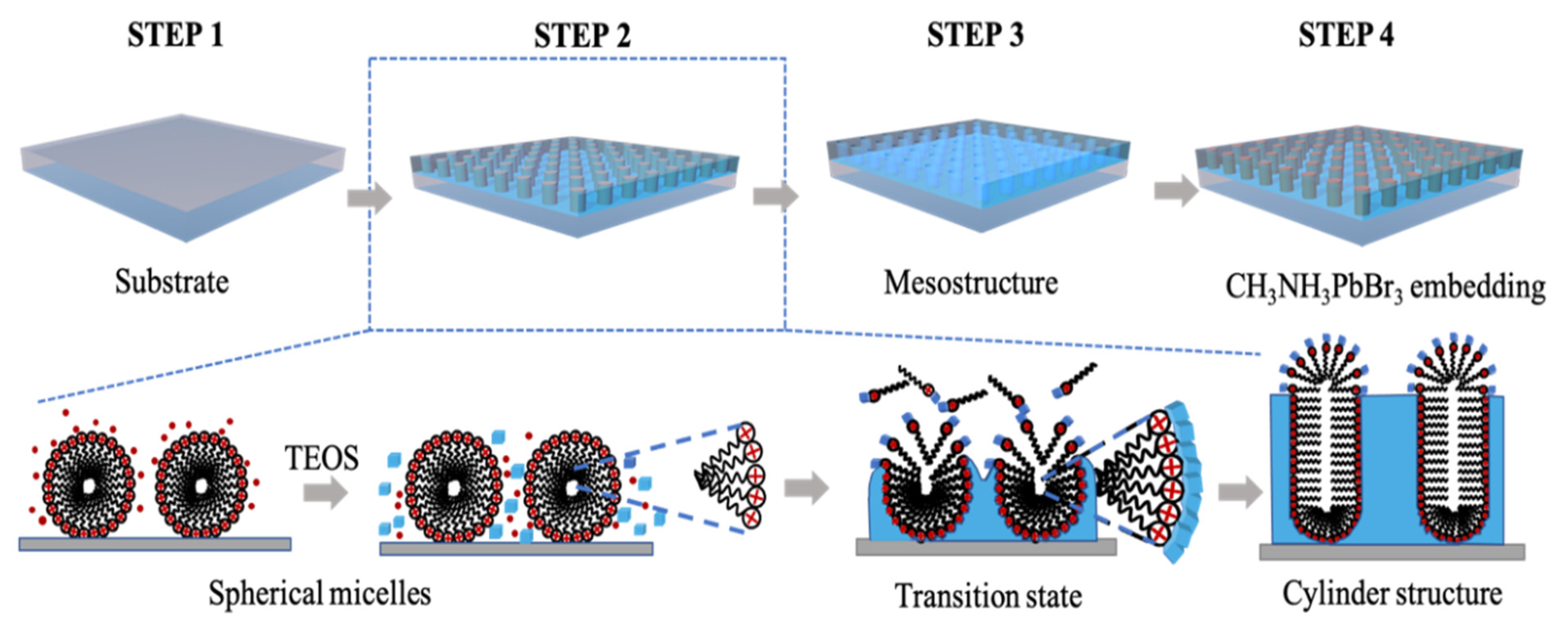
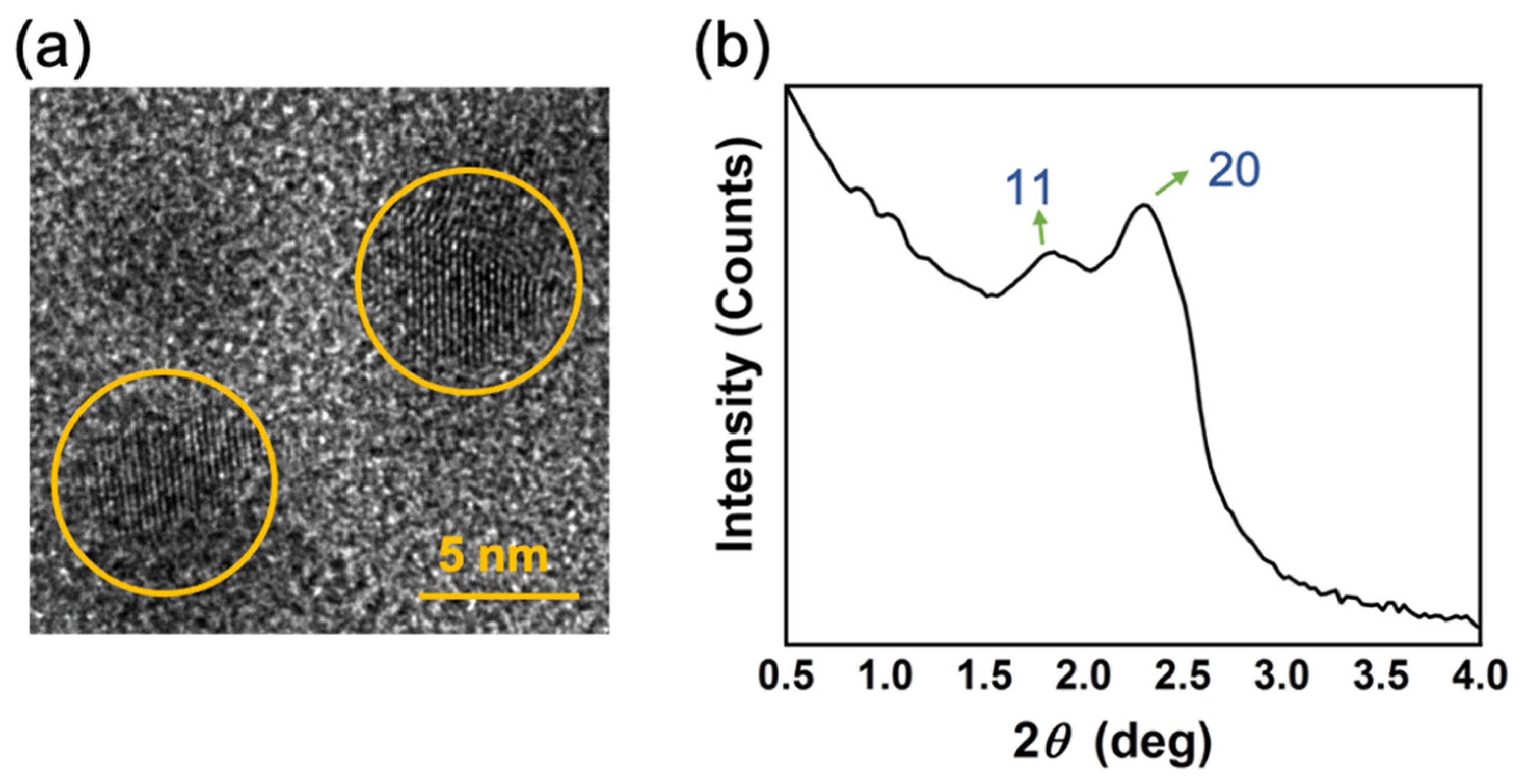
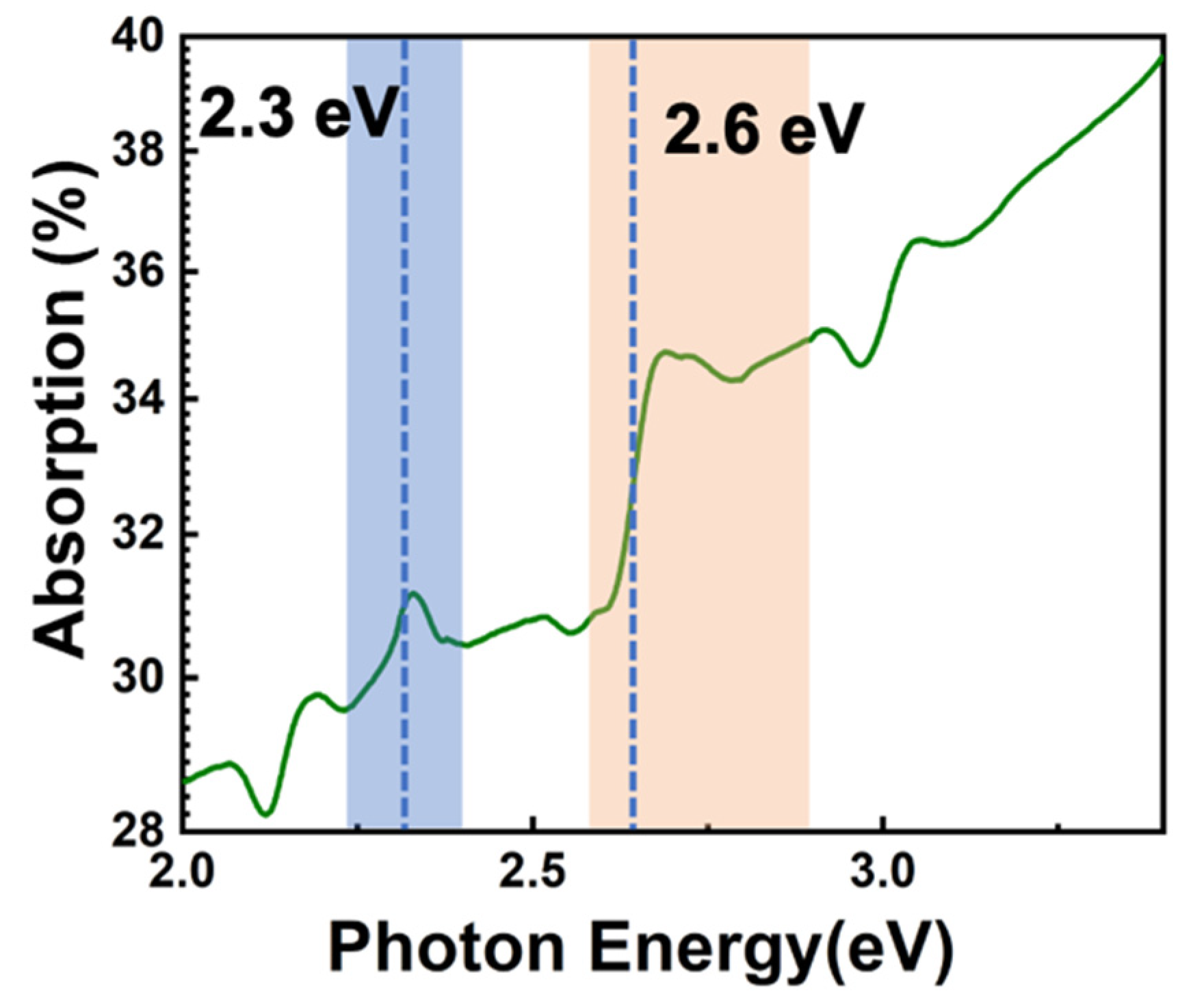
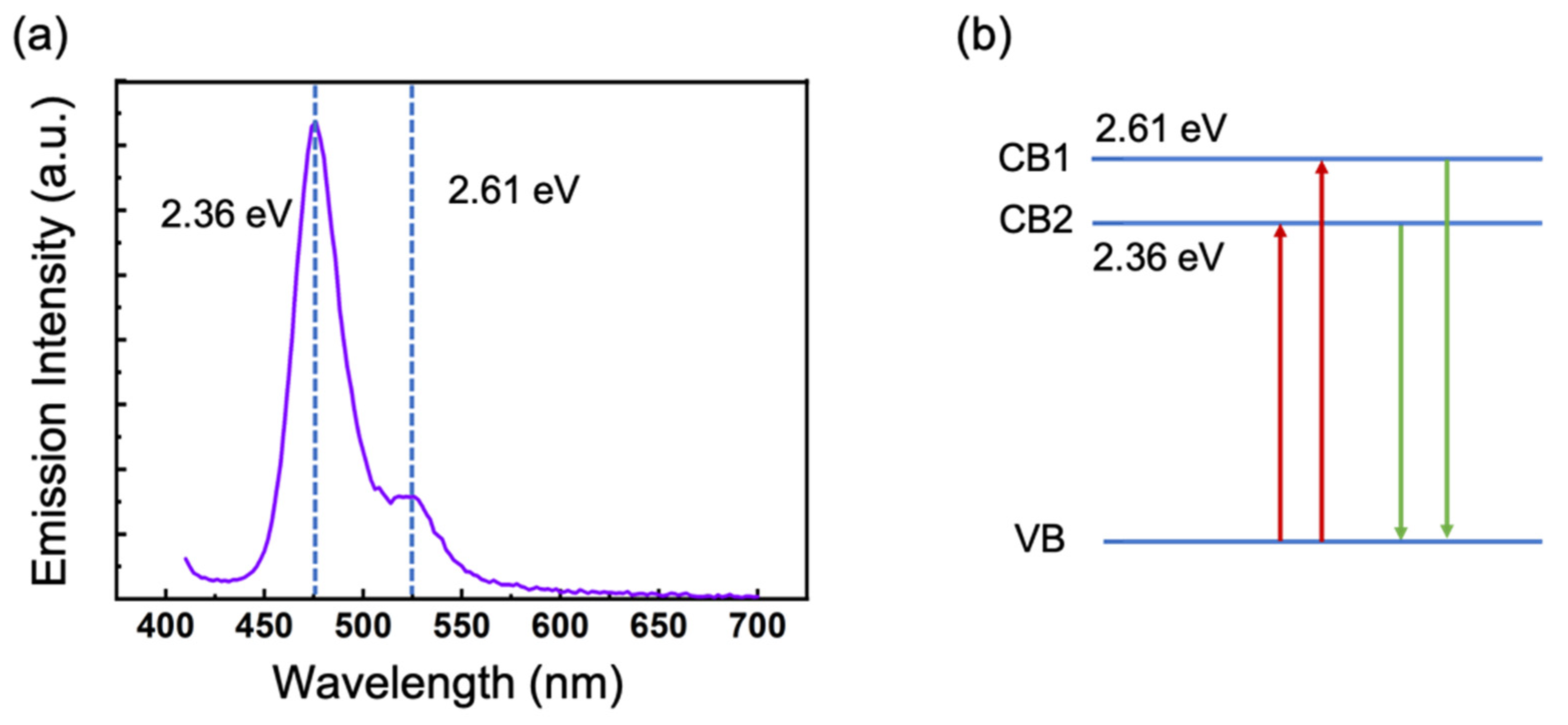
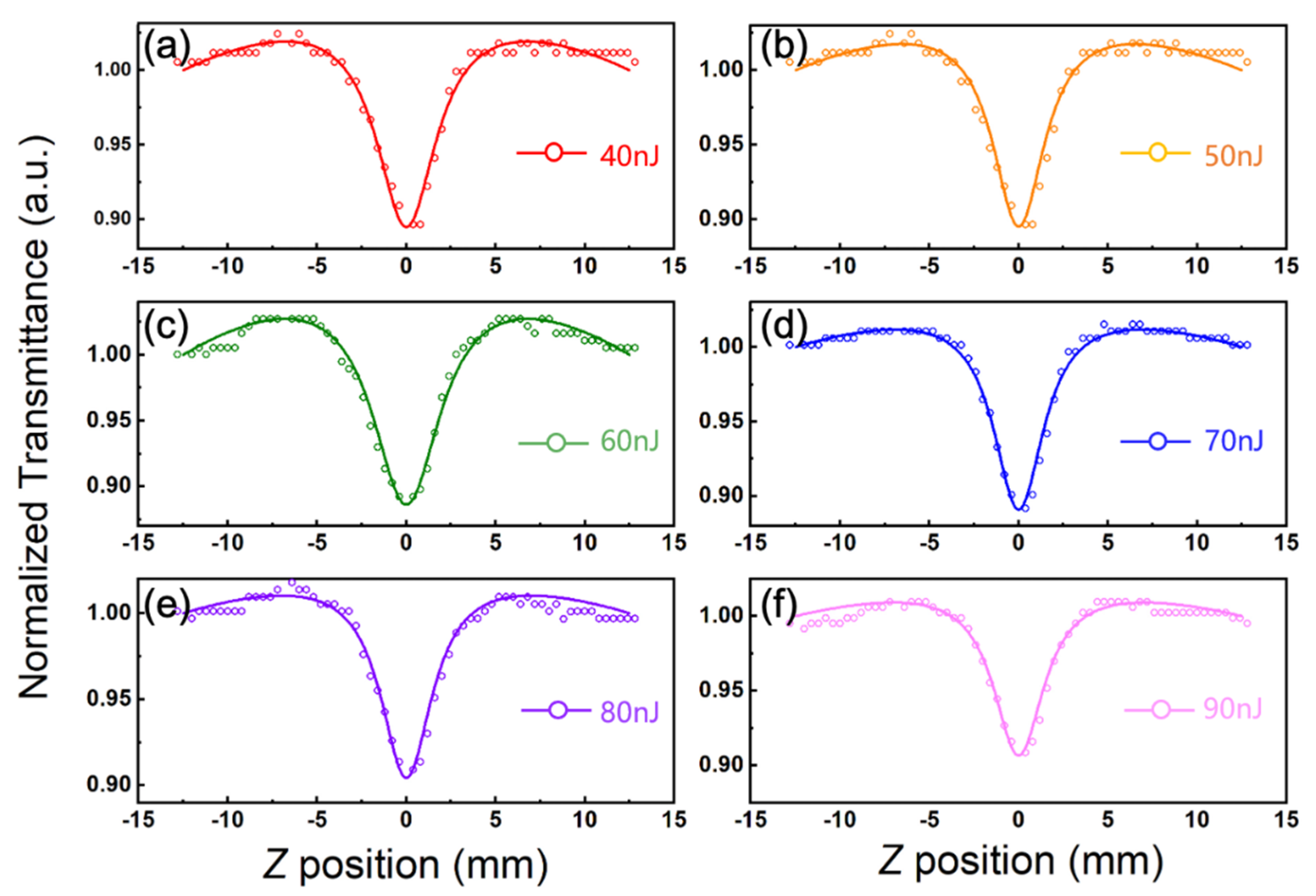
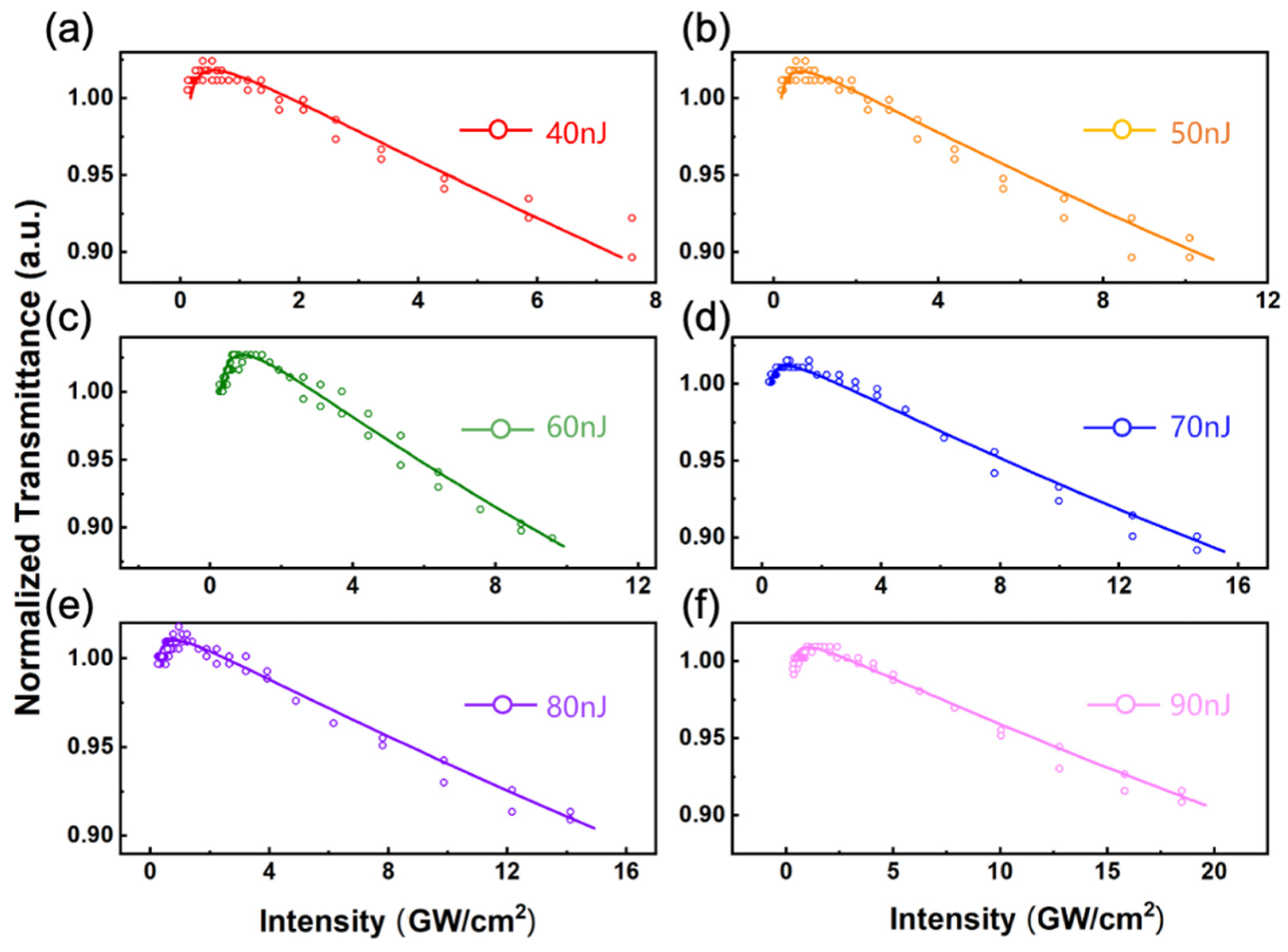
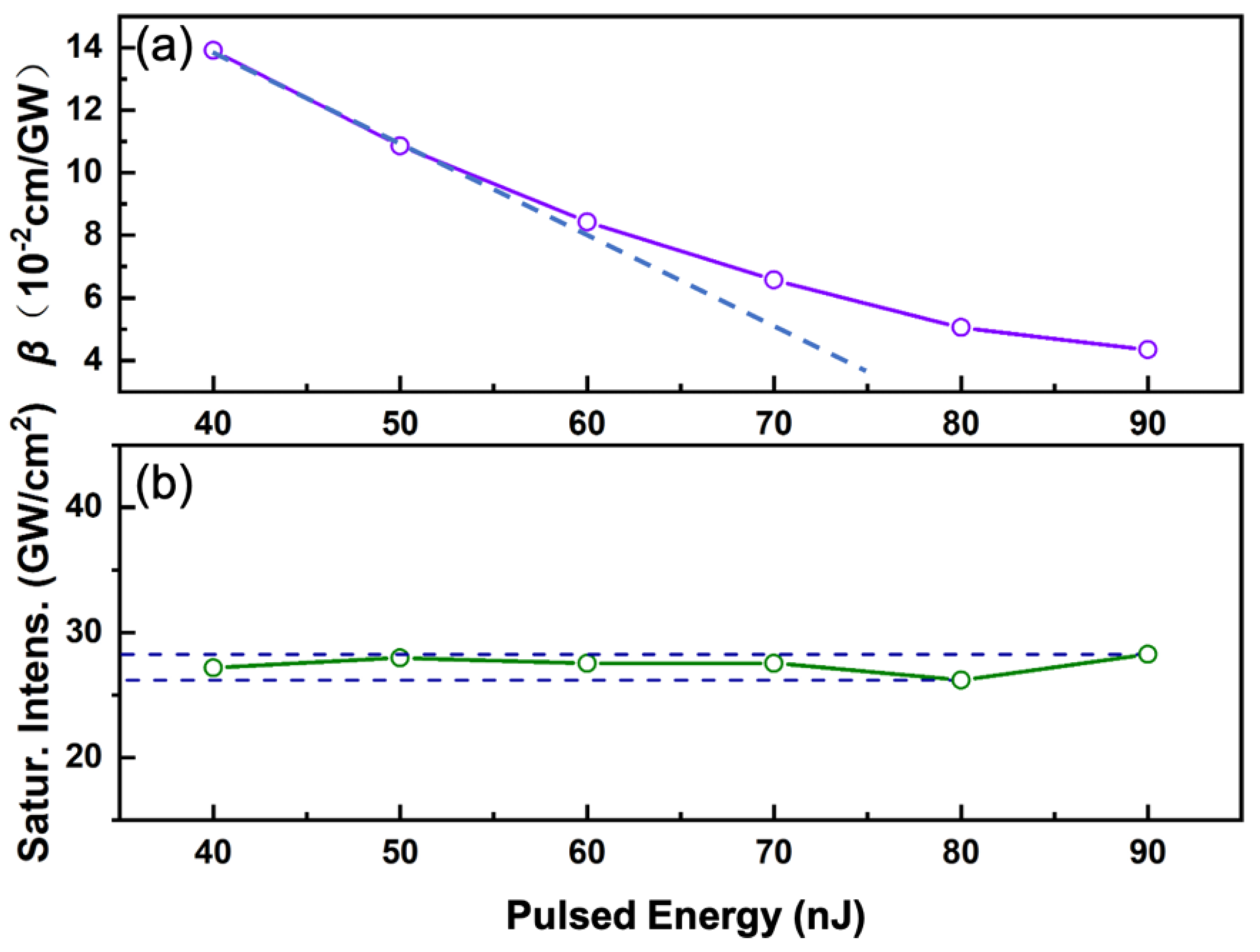
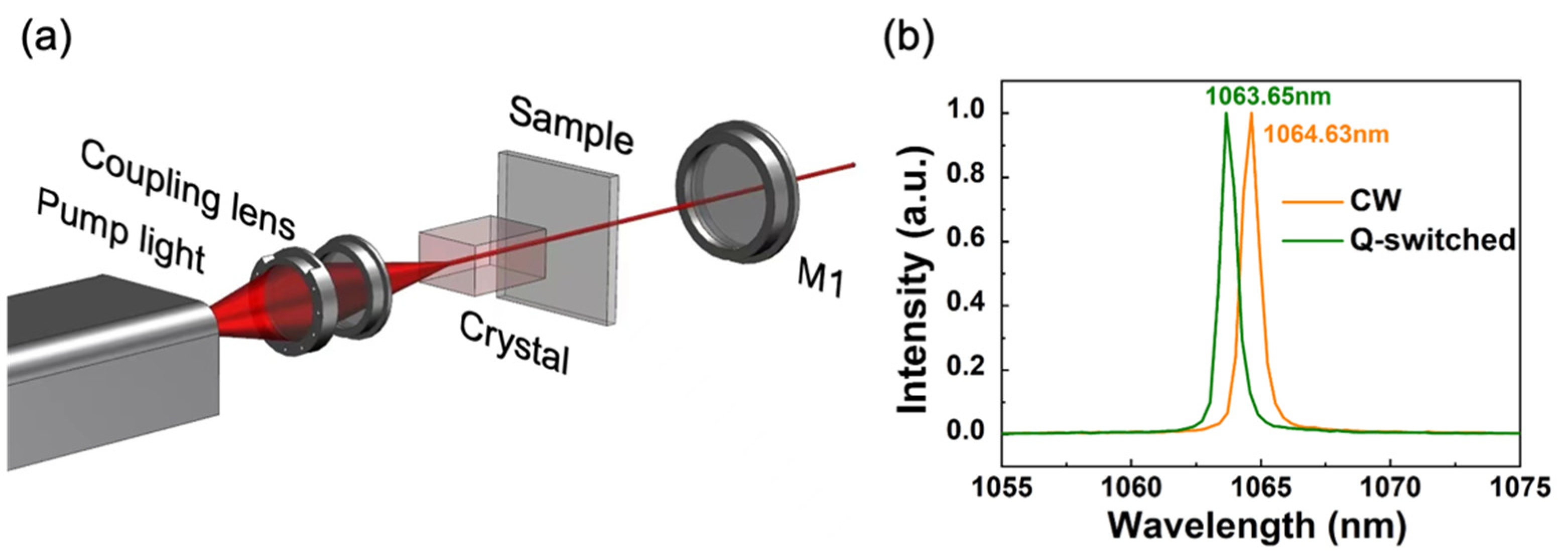
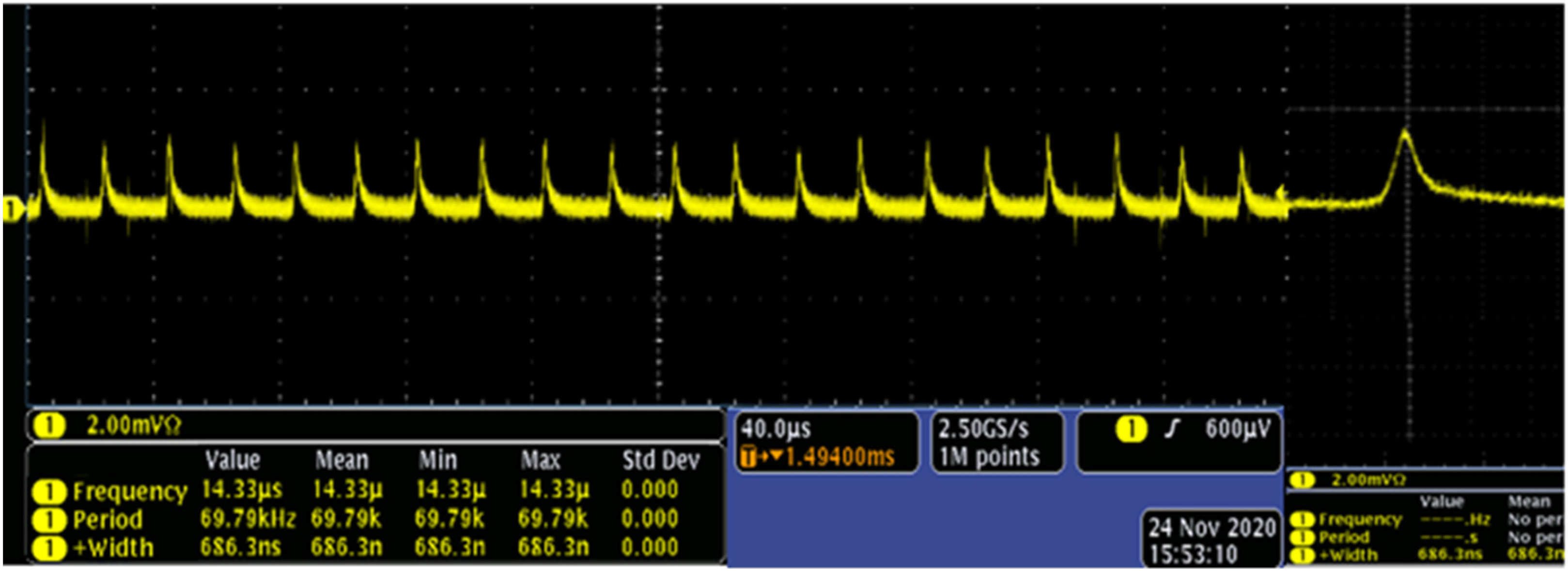
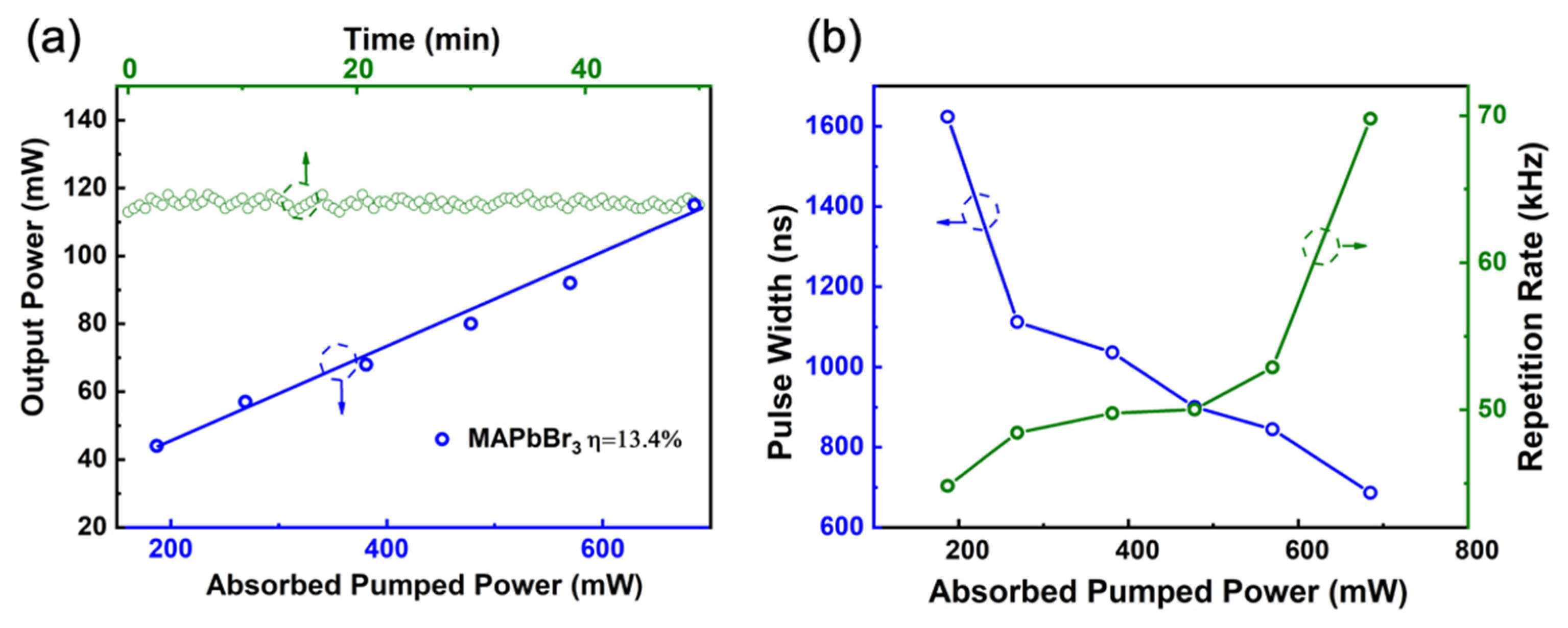
Publisher’s Note: MDPI stays neutral with regard to jurisdictional claims in published maps and institutional affiliations. |
© 2021 by the authors. Licensee MDPI, Basel, Switzerland. This article is an open access article distributed under the terms and conditions of the Creative Commons Attribution (CC BY) license (https://creativecommons.org/licenses/by/4.0/).
Share and Cite
Dong, S.; Zhang, C.; Zhou, Y.; Miao, X.; Zong, T.; Gu, M.; Zhan, Z.; Chen, D.; Ma, H.; Gui, W.; et al. High-Stability Hybrid Organic-Inorganic Perovskite (CH3NH3PbBr3) in SiO2 Mesopores: Nonlinear Optics and Applications for Q-Switching Laser Operation. Nanomaterials 2021, 11, 1648. https://doi.org/10.3390/nano11071648
Dong S, Zhang C, Zhou Y, Miao X, Zong T, Gu M, Zhan Z, Chen D, Ma H, Gui W, et al. High-Stability Hybrid Organic-Inorganic Perovskite (CH3NH3PbBr3) in SiO2 Mesopores: Nonlinear Optics and Applications for Q-Switching Laser Operation. Nanomaterials. 2021; 11(7):1648. https://doi.org/10.3390/nano11071648
Chicago/Turabian StyleDong, Siyu, Cheng Zhang, Yuxiang Zhou, Xiaona Miao, Tiantian Zong, Manna Gu, Zijun Zhan, Duo Chen, Hong Ma, Weiling Gui, and et al. 2021. "High-Stability Hybrid Organic-Inorganic Perovskite (CH3NH3PbBr3) in SiO2 Mesopores: Nonlinear Optics and Applications for Q-Switching Laser Operation" Nanomaterials 11, no. 7: 1648. https://doi.org/10.3390/nano11071648
APA StyleDong, S., Zhang, C., Zhou, Y., Miao, X., Zong, T., Gu, M., Zhan, Z., Chen, D., Ma, H., Gui, W., Liu, J., Cheng, C., & Cheng, C. (2021). High-Stability Hybrid Organic-Inorganic Perovskite (CH3NH3PbBr3) in SiO2 Mesopores: Nonlinear Optics and Applications for Q-Switching Laser Operation. Nanomaterials, 11(7), 1648. https://doi.org/10.3390/nano11071648





